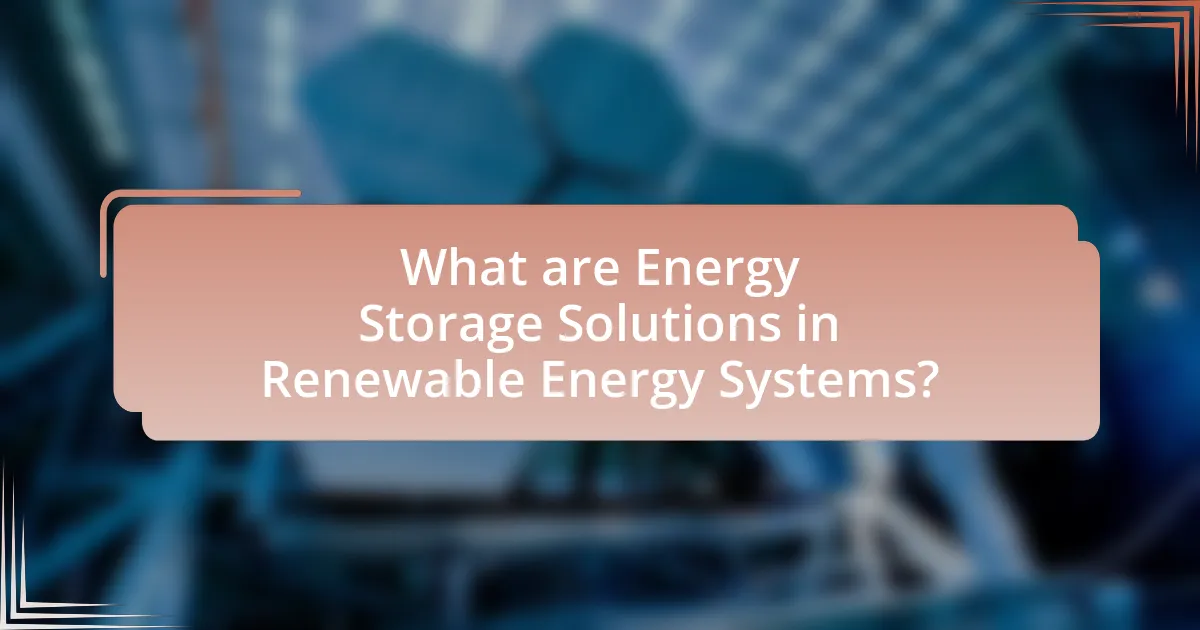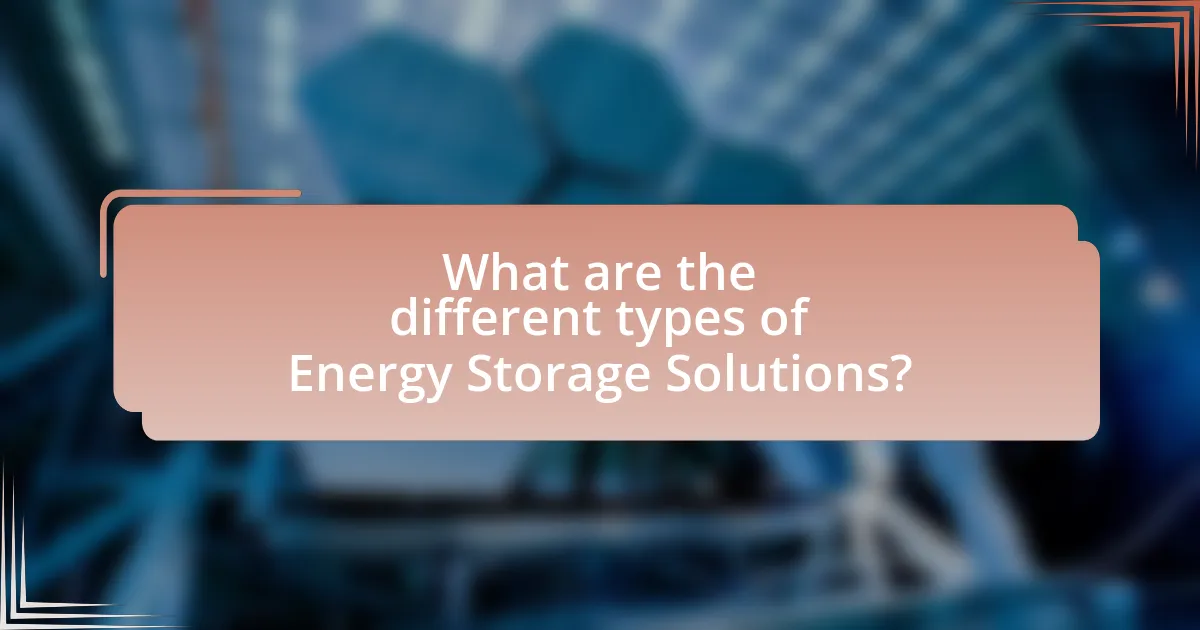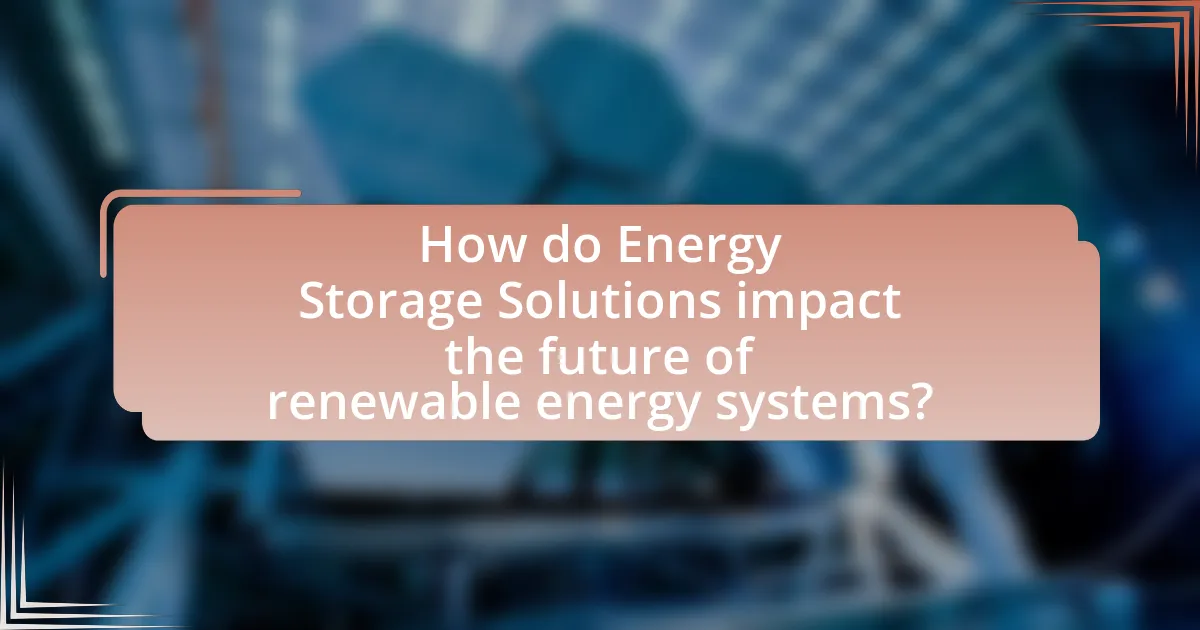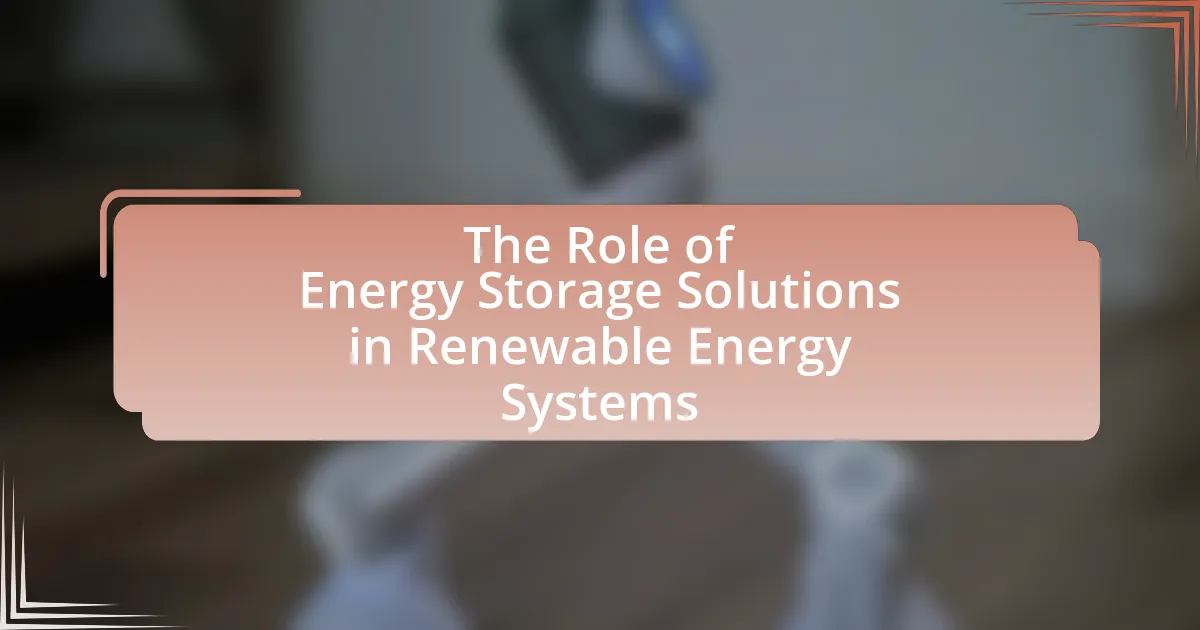Energy storage solutions are critical components in renewable energy systems, enabling the capture and storage of energy generated from sources like solar and wind for later use. These technologies, including batteries, pumped hydro storage, and thermal storage, help manage energy supply and demand, ensuring reliability even during periods of intermittent generation. The article explores how energy storage integrates with renewable sources, enhances grid stability, and addresses challenges faced without such systems. It also examines various energy storage technologies, their advantages and disadvantages, cost implications, environmental impacts, and the role of government policies in their development, ultimately highlighting the importance of energy storage in achieving a sustainable energy future.

What are Energy Storage Solutions in Renewable Energy Systems?
Energy storage solutions in renewable energy systems are technologies that capture and store energy generated from renewable sources for later use. These solutions, such as batteries, pumped hydro storage, and thermal storage, enable the management of energy supply and demand, ensuring a stable and reliable energy supply even when generation is intermittent, as seen with solar and wind energy. For instance, according to the International Renewable Energy Agency (IRENA), energy storage capacity has been growing rapidly, with global installed battery storage capacity reaching over 20 gigawatts in 2020, highlighting its critical role in enhancing the efficiency and reliability of renewable energy systems.
How do Energy Storage Solutions integrate with renewable energy sources?
Energy storage solutions integrate with renewable energy sources by capturing excess energy generated during peak production times and releasing it during periods of low generation or high demand. This integration enhances the reliability and stability of renewable energy systems, such as solar and wind, which are inherently variable. For instance, battery storage systems can store solar energy produced during the day for use at night, ensuring a continuous power supply. According to the U.S. Department of Energy, energy storage can increase the utilization of renewable resources by up to 30%, thereby facilitating a smoother transition to a low-carbon energy grid.
What types of renewable energy sources benefit from energy storage?
Renewable energy sources that benefit from energy storage include solar energy, wind energy, and hydropower. Energy storage systems, such as batteries and pumped hydro storage, help to manage the intermittent nature of these sources by storing excess energy generated during peak production times and releasing it during periods of low generation. For instance, solar energy production peaks during the day, while energy demand often peaks in the evening; energy storage allows for this mismatch to be addressed effectively. Similarly, wind energy can be variable, and energy storage can smooth out the supply to match demand. According to the International Renewable Energy Agency (IRENA), integrating energy storage with renewable sources can enhance grid stability and reliability, making these systems more efficient and effective.
How does energy storage enhance the reliability of renewable energy systems?
Energy storage enhances the reliability of renewable energy systems by providing a buffer that balances supply and demand. This capability allows energy storage systems, such as batteries, to store excess energy generated during peak production times, such as sunny or windy days, and release it during periods of low generation or high demand. For instance, according to the International Renewable Energy Agency (IRENA), integrating energy storage can increase the reliability of renewable systems by up to 30%, ensuring a consistent energy supply even when renewable sources are intermittent. This stabilization reduces the risk of outages and enhances grid resilience, making renewable energy a more dependable option for meeting energy needs.
Why are Energy Storage Solutions essential for renewable energy systems?
Energy storage solutions are essential for renewable energy systems because they enable the management of energy supply and demand, ensuring a stable and reliable energy output. Renewable energy sources, such as solar and wind, are inherently intermittent, producing energy only when conditions are favorable. Energy storage systems, like batteries, allow excess energy generated during peak production times to be stored and released during periods of low production or high demand. For instance, according to the International Renewable Energy Agency (IRENA), energy storage can increase the share of renewables in the energy mix by providing grid stability and flexibility, which is crucial for integrating higher levels of renewable energy.
What challenges do renewable energy systems face without energy storage?
Renewable energy systems face significant challenges without energy storage, primarily due to their intermittent nature. For instance, solar and wind energy generation is dependent on weather conditions and time of day, leading to periods of excess generation and scarcity. This variability can result in grid instability, making it difficult to match supply with demand. According to the U.S. Department of Energy, without energy storage, renewable sources could lead to a 30% reduction in grid reliability, as traditional power plants cannot quickly adjust to fluctuations in renewable output. Additionally, the lack of storage limits the ability to utilize generated energy during peak demand times, ultimately hindering the transition to a sustainable energy future.
How do energy storage solutions contribute to grid stability?
Energy storage solutions contribute to grid stability by providing backup power during peak demand and balancing supply and demand fluctuations. These systems, such as batteries and pumped hydro storage, can quickly release energy when there is a shortfall and absorb excess energy during low demand periods. For instance, according to the U.S. Department of Energy, energy storage can enhance grid reliability by reducing the frequency and duration of outages, thereby maintaining a stable electricity supply. Additionally, the integration of energy storage with renewable sources like solar and wind helps mitigate their intermittent nature, ensuring a consistent energy flow to the grid.

What are the different types of Energy Storage Solutions?
The different types of energy storage solutions include batteries, pumped hydro storage, compressed air energy storage, flywheels, and thermal energy storage. Batteries, such as lithium-ion and lead-acid, store electrical energy chemically and are widely used for grid and residential applications. Pumped hydro storage utilizes gravitational potential energy by moving water between two reservoirs at different elevations, accounting for about 95% of global energy storage capacity. Compressed air energy storage involves storing energy in the form of compressed air in underground caverns, which can be released to generate electricity. Flywheels store kinetic energy and provide rapid response times for grid stability. Thermal energy storage captures heat for later use, often in concentrated solar power systems. Each of these solutions plays a crucial role in enhancing the reliability and efficiency of renewable energy systems.
What are the most common technologies used in energy storage?
The most common technologies used in energy storage are lithium-ion batteries, pumped hydro storage, and compressed air energy storage. Lithium-ion batteries dominate the market due to their high energy density and efficiency, accounting for approximately 90% of the global battery storage market as of 2023. Pumped hydro storage, which utilizes gravitational potential energy, represents about 95% of the world’s large-scale energy storage capacity, making it a reliable option for balancing supply and demand. Compressed air energy storage, while less common, is gaining traction for its ability to store large amounts of energy over extended periods, with several projects demonstrating its viability.
How do lithium-ion batteries compare to other storage technologies?
Lithium-ion batteries offer higher energy density and efficiency compared to other storage technologies such as lead-acid batteries and pumped hydro storage. Specifically, lithium-ion batteries can achieve energy densities of 150-250 Wh/kg, while lead-acid batteries typically range from 30-50 Wh/kg. Additionally, lithium-ion batteries have a round-trip efficiency of about 90-95%, significantly higher than the 70-80% efficiency of lead-acid batteries. In contrast, pumped hydro storage, while capable of storing large amounts of energy, has geographical limitations and lower energy density, making it less versatile for applications requiring compact solutions. These characteristics position lithium-ion batteries as a preferred choice in renewable energy systems, particularly for applications like electric vehicles and grid storage, where space and efficiency are critical.
What role do pumped hydro storage systems play in energy storage?
Pumped hydro storage systems serve as a crucial component in energy storage by enabling the efficient management of electricity supply and demand. These systems work by using excess electricity to pump water to a higher elevation, storing potential energy, which can later be released to generate electricity when demand peaks. According to the U.S. Department of Energy, pumped hydro accounts for approximately 95% of all utility-scale energy storage in the United States, demonstrating its significance in balancing grid stability and integrating renewable energy sources like wind and solar.
What are the advantages and disadvantages of various energy storage technologies?
Energy storage technologies offer various advantages and disadvantages that impact their effectiveness in renewable energy systems. Lithium-ion batteries, for example, provide high energy density and efficiency, making them suitable for applications like electric vehicles and grid storage. However, they have limitations such as high costs and environmental concerns related to mining and disposal.
Pumped hydro storage is another technology that allows for large-scale energy storage with a long lifespan and low operational costs. Its disadvantage lies in geographical limitations and the significant infrastructure required, which can be costly and time-consuming to develop.
Flywheel energy storage systems offer rapid response times and high cycle life, making them ideal for short-term energy needs. However, they have lower energy density compared to batteries and can be expensive to install.
Compressed air energy storage (CAES) can store large amounts of energy and has a long operational life, but it requires specific geological formations and can have lower round-trip efficiency compared to other technologies.
Overall, the choice of energy storage technology depends on specific application requirements, cost considerations, and environmental impacts.
What are the cost implications of different energy storage solutions?
The cost implications of different energy storage solutions vary significantly based on technology, capacity, and application. For instance, lithium-ion batteries, widely used for their efficiency and scalability, can cost between $200 to $400 per kilowatt-hour, making them suitable for residential and commercial applications. In contrast, pumped hydro storage, which is the most established large-scale storage method, has a lower cost per kilowatt-hour, typically ranging from $100 to $200, but requires significant geographical and infrastructural considerations. Additionally, flow batteries, while offering longer cycle life and scalability, have higher initial costs, often exceeding $500 per kilowatt-hour, which can limit their adoption in certain markets. These cost variations highlight the importance of selecting the appropriate energy storage solution based on specific project requirements and economic feasibility.
How do environmental impacts vary among energy storage technologies?
Environmental impacts vary significantly among energy storage technologies, primarily due to differences in materials, lifecycle emissions, and land use. For instance, lithium-ion batteries, widely used for their high energy density, have substantial environmental concerns related to lithium extraction, which can lead to water depletion and pollution. In contrast, pumped hydro storage, while having a lower carbon footprint during operation, can disrupt local ecosystems and require significant land for reservoirs. Additionally, flow batteries, which utilize liquid electrolytes, may pose risks related to chemical leakage but generally have a longer lifespan and lower toxicity compared to conventional batteries. These variations highlight the need for careful consideration of environmental trade-offs when selecting energy storage solutions for renewable energy systems.

How do Energy Storage Solutions impact the future of renewable energy systems?
Energy storage solutions significantly enhance the reliability and efficiency of renewable energy systems by enabling the storage of excess energy generated during peak production times for use during periods of low generation. This capability addresses the intermittent nature of renewable sources like solar and wind, which can produce energy inconsistently due to weather conditions. For instance, according to the International Renewable Energy Agency (IRENA), energy storage can increase the share of renewables in the energy mix by providing grid stability and reducing reliance on fossil fuels. Furthermore, advancements in battery technologies, such as lithium-ion batteries, have led to decreased costs and improved performance, making energy storage more accessible and effective. As a result, energy storage solutions are crucial for achieving a sustainable energy future, facilitating the transition to a low-carbon economy.
What trends are emerging in energy storage technology?
Emerging trends in energy storage technology include the advancement of solid-state batteries, increased adoption of lithium-sulfur batteries, and the integration of artificial intelligence for optimized energy management. Solid-state batteries, which utilize a solid electrolyte instead of a liquid one, promise higher energy densities and improved safety, with companies like QuantumScape reporting potential energy densities of over 400 Wh/kg. Lithium-sulfur batteries are gaining traction due to their lower cost and higher theoretical capacity compared to traditional lithium-ion batteries, with research indicating they could achieve up to 2,600 Wh/kg. Additionally, the use of artificial intelligence in energy storage systems enhances predictive analytics and operational efficiency, as demonstrated by projects that utilize AI to forecast energy demand and optimize battery usage, leading to cost savings and improved grid stability.
How is innovation shaping the future of energy storage solutions?
Innovation is significantly shaping the future of energy storage solutions by enhancing efficiency, reducing costs, and increasing the capacity of storage technologies. For instance, advancements in lithium-ion battery technology have led to a 50% reduction in costs over the past decade, making energy storage more accessible for renewable energy systems. Additionally, the development of solid-state batteries promises higher energy densities and improved safety compared to traditional lithium-ion batteries. Furthermore, innovations in flow batteries and other alternative storage methods are expanding the range of applications, enabling longer-duration energy storage that is crucial for balancing intermittent renewable energy sources like solar and wind. These innovations collectively drive the transition towards a more sustainable and resilient energy infrastructure.
What role do government policies play in the development of energy storage?
Government policies significantly influence the development of energy storage by providing regulatory frameworks, financial incentives, and research funding. These policies can accelerate technological advancements and market adoption by establishing standards, such as safety and performance requirements, which ensure reliability and efficiency in energy storage systems. For instance, the U.S. Department of Energy has invested billions in energy storage research and development, leading to innovations like lithium-ion batteries, which have seen a 70% reduction in costs since 2010 due to supportive policies. Additionally, policies such as tax credits and grants encourage private investment in energy storage projects, further driving growth in this sector.
What are the best practices for implementing Energy Storage Solutions?
The best practices for implementing Energy Storage Solutions include conducting a thorough feasibility study, selecting appropriate technology, and ensuring integration with existing energy systems. A feasibility study assesses the specific energy needs, potential savings, and return on investment, which is crucial for informed decision-making. Choosing the right technology, such as lithium-ion batteries or pumped hydro storage, depends on factors like capacity, discharge duration, and cost-effectiveness. Furthermore, successful integration with renewable energy sources, such as solar or wind, enhances system reliability and efficiency, as evidenced by projects like the Hornsdale Power Reserve in Australia, which demonstrated improved grid stability and reduced energy costs.
How can organizations effectively assess their energy storage needs?
Organizations can effectively assess their energy storage needs by conducting a comprehensive analysis of their energy consumption patterns, peak demand times, and renewable energy generation profiles. This assessment involves collecting data on historical energy usage, identifying periods of high demand, and evaluating the variability of renewable energy sources such as solar and wind. For instance, a study by the National Renewable Energy Laboratory indicates that understanding these factors allows organizations to determine the optimal size and type of energy storage systems required to balance supply and demand effectively. By utilizing modeling tools and simulations, organizations can predict future energy needs and make informed decisions about the capacity and technology of energy storage solutions that align with their operational goals.
What common pitfalls should be avoided when integrating energy storage?
Common pitfalls to avoid when integrating energy storage include inadequate sizing of the storage system, neglecting to consider the specific application requirements, and failing to account for lifecycle costs. Inadequate sizing can lead to insufficient energy supply or excessive costs, as seen in projects where storage capacity did not match demand patterns. Neglecting application requirements, such as response time and discharge duration, can result in poor performance and unmet operational goals. Additionally, overlooking lifecycle costs, including maintenance and replacement, can lead to budget overruns and reduced project viability. These pitfalls highlight the importance of thorough planning and analysis in energy storage integration.


